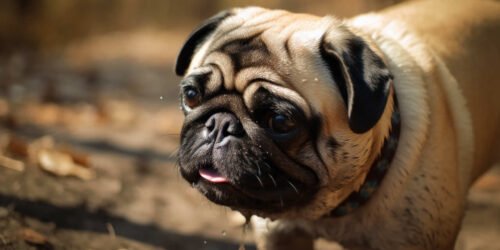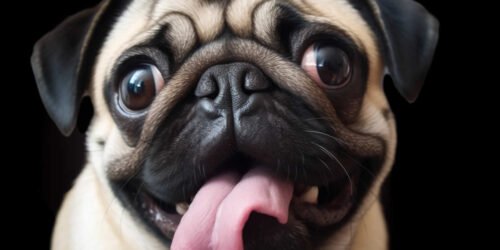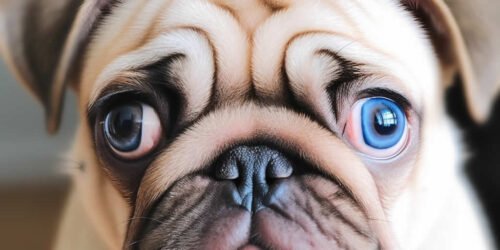Do Pugs Shed?
Introduction
Ah, pugs – those lovable, wrinkly-faced companions that have stolen the hearts of dog lovers everywhere. But there’s one question that often pops up when considering a pug as a pet: do they shed? The short answer is yes, and quite a bit at that! However, this blog will explore the ins and outs of pug shedding, including understanding their fur characteristics and factors affecting how much they shed.
Additionally, we’ll provide tips on managing all that loose pug hair so you can still enjoy your adorable best friend without being covered in fur.

Table of Contents
- Introduction
- Understanding Pug Shedding
- Factors Affecting Pug Shedding
- Managing Pug Shedding
- FAQs
- Conclusion
Key Takeaways
- Pugs are heavy-shedding dogs with a double coat that sheds year-round, especially during seasonal transitions.
- Genetics, diet and nutrition, age and health, and environmental allergens all play a role in how much a pug sheds.
- Regular grooming and brushing using de – shedding tools and products can help manage shedding. Proper bathing and drying techniques are also important.
- Choosing appropriate clothing and furniture can also help control shedding around the house.
Understanding Pug Shedding
Pug shedding is a natural and ongoing process due to their characteristic double coat, which includes a thicker undercoat that sheds seasonally and an outer layer of short hairs that shed year-round.
Pug Fur Characteristics
As a potential Pug owner, it’s essential to understand their unique fur characteristics. Pugs have a distinctive double coat that comprises a soft undercoat and a coarse outer layer.
It is important to note that there are two main color variations for this breed: fawn and black. While both types shed, fawn-colored Pugs tend to shed more because of their lighter undercoat hairs which become more noticeable on clothing, furniture, and other surfaces around your home.
Frequency Of Shedding
As a potential pug owner, it’s essential to understand that these adorable dogs shed quite frequently. Pugs are considered a heavy shedding breed, which means you’ll find their fur around your home on a regular basis.
The frequency at which your pug sheds can depend on various factors such as coat color and time of year. For example, fawn-colored pugs tend to shed more than black ones due to their lighter fur and double coat.
Although pugs generally shed about the same amount all year long, they might experience seasonal shedding changes during spring or fall when transitioning between warm and cold weather conditions.
Shedding Vs. Hair Loss
As a pug parent, it’s essential to identify the difference between normal shedding and hair loss in your furry friend. Shedding is a natural process that occurs in all dogs, including pugs, as their body replaces old fur with new growth.
Pugs shed more than most breeds due to their short coat with a short hair growth cycle and an undercoat continuously growing and pushing out.
Hair loss can result from various factors such as allergies, hormonal imbalances, or even stress. For instance, my neighbor’s pug once started losing hair around its neck area because of an allergy to a new collar they had purchased for him.
It took some detective work along with help from their vet before they figured out what was causing it! So keep an eye on any changes in your pet’s fur-shedding patterns – if you suspect something isn’t right about your pug’s shedding levels or see any unusual signs like redness or irritation on the skin beneath the fur, consult with a veterinarian for guidance and proper diagnosis.
Factors Affecting Pug Shedding
Genetics, diet and nutrition, age and health, and environmental allergens all play a role in how much a pug sheds.
Genetics
One thing to keep in mind when considering a pug as a pet is that genetics play a role in their shedding habits. Pugs with the SD/SD or sd/sd alleles tend to shed less than those with the Sd allele, which has been associated with moderate shedding.
This means that if you are looking for a low-shedding dog, it is important to research the genetic history of any potential pug companions. However, it’s worth noting that even genetically low-shedding pugs will still lose some fur, especially during seasonal changes or times of stress.
Diet And Nutrition
As with humans, a Pug’s diet and nutrition play a crucial role in their overall health and well-being. Feeding your Pug high-quality food with the right balance of nutrients is essential not only for maintaining healthy skin and coat but also for controlling shedding.
A poor diet lacking essential vitamins, minerals, or fatty acids can lead to excessive shedding and even hair loss. Including supplements such as omega 3 and 6 or flaxseed oil in your Pug’s diet can help reduce shedding while promoting healthy skin and coat.
Additionally, it’s important to avoid overfeeding your Pug as obesity can also lead to shedding due to the excess strain on their body.
Age And Health
As with all animals, age and health can play a role in how much a Pug sheds. Older Pugs may experience more shedding due to the natural aging process, while those with certain health issues such as allergies or thyroid problems may shed more than others.
It’s important to keep up with regular vet check-ups and monitor any changes in your Pug’s shedding patterns. Additionally, providing your Pug with high-quality nutrition and proper grooming can greatly reduce excessive shedding.
As an experienced pug owner myself, I have noticed that my older Pug sheds more during seasonal transitions or when he has not been feeling well.
Environmental Allergens
As much as we love our furry companions, allergies can be a pesky problem for some pug owners. Environmental allergens like dust mites, pollen and fleas are common triggers that can exacerbate shedding in pugs.
These irritants can cause your pup to itch excessively, leading to hair loss and increased shedding. It’s important to ensure your home is free of common allergens by vacuuming regularly and washing bedding with hypoallergenic detergents.
Managing Pug Shedding
To keep pug shedding under control, regular grooming and brushing is important. You should also consider using de-shedding tools and products, as well as proper bathing and drying techniques.

Regular Grooming And Brushing
As a proud pug owner, I can attest to the importance of regular grooming and brushing to manage shedding. Here are some tips:
- Brush your Pug daily during shedding seasons (summer and winter) using a soft-bristled brush or a de-shedding tool. This will remove loose and dead fur that has accumulated in their coat.
- During nonshedding seasons, you can reduce brushing frequency to once or twice a week.
- Use a detangling spray or conditioner to make brushing easier and prevent hair breakage.
- Bathe your Pug no more than once a month as over – bathing can dry out their skin and worsen shedding.
- After bathing, pat your Pug’s coat dry with a towel instead of rubbing to avoid tangling and matting.
- Regular grooming and brushing strengthens the hair follicles, promotes healthy skin, and reduces the amount of fur shed by your Pug.
Remember, keeping up with regular grooming is key to managing pug shedding!
Proper Bathing And Drying Techniques
If you’re looking to manage your pug’s shedding, proper bathing and drying techniques are essential. Here are some tips to help you get started:
- Use a gentle shampoo: Choose a shampoo that is specifically formulated for dogs with sensitive skin. Avoid using human shampoos, as they can be too harsh for your pug’s delicate skin.
- Rinse thoroughly: Make sure you rinse your pug off thoroughly after shampooing to remove any soap residue that might irritate their skin and cause them to shed more.
- Use lukewarm water: Always use lukewarm water when bathing your pug. Using hot water can dry out their skin and cause excessive shedding.
- Dry gently: Pat your pug dry with a towel after their bath instead of rubbing them vigorously, as this can damage their fur and lead to even more shedding.
- Consider using a blow dryer: If your pug has long hair, consider using a low heat setting on a blow dryer to help speed up the drying process. But be careful not to hold the dryer too close or use it on high heat, which can burn their sensitive skin and make them shed even more.
By following these simple tips, you’ll be able to keep your pug clean and comfortable while managing their shedding at the same time!
Use Of De-shedding Tools And Products
As a Pug owner, I know firsthand how frustrating it can be to deal with shedding issues. Fortunately, there are various de-shedding tools and products that can help manage this problem. Here are some options to consider:
- Furminator De-shedding Tool: This tool is specifically designed for dogs with thick fur and helps remove loose hair without damaging the coat.
- ZoomGroom Rubber Brush: The rubber bristles on this brush help massage your Pug’s skin while also removing dead hair.
- Shed-X Dermaplex Liquid Supplement: Adding this supplement to your Pug’s daily diet can help reduce shedding and promote healthier skin and coat.
- Burt’s Bees Natural Shampoo: This all-natural shampoo is gentle on your Pug’s sensitive skin and helps keep their coat healthy and shiny.
- FURminator deShedding Ultra Premium Dog Conditioner: This conditioner helps reduce shedding by releasing the undercoat during the bath, making it easier to remove later.
By using these de-shedding tools and products, you can effectively manage your Pug’s shedding and keep their coat looking healthy and beautiful.
Choosing Appropriate Clothing And Furniture
As a pug owner, you may have noticed that shedding fur all over your clothes and furniture is inevitable. However, there are ways to manage shedding in your home by choosing appropriate clothing and furniture.
Opt for materials like leather or vinyl for couches and chairs instead of fabrics that trap pet hair. When it comes to selecting bedding or blankets, consider using ones made of microfiber.
Additionally, dressing up your pug in specially designed jackets can control shedding around the house while providing extra warmth during colder seasons. Investing in a good quality jacket can keep loose hairs from sticking onto upholstery and carpeting surfaces as well.
FAQs
– Do Pugs Shed a Lot?
Yes, Pugs can shed quite a bit due to their double coat and year-round shedding.
– How to Control Pug Shedding?
Regular grooming, proper bathing and drying techniques, use of de-shedding tools and products, as well as choosing appropriate clothing and furniture can help manage shedding.
– Do Black Pugs Shed Less?
Black pugs tend to have single coats and may shed less than other pug colors.
Do Pugs Shed A Lot?
As a proud pug owner, I can say with certainty that yes, Pugs do shed quite a bit. In fact, they are considered to be among the heaviest shedding breeds out there. Their double coat of fur means that they have more hair packed into their tiny frames per square inch of their bodies compared to other breeds.
Shedding is year-round for Pugs and may almost twice as much as most dogs because of their coat.
It’s important to note that while Pugs do shed quite a bit, there are ways to manage it effectively through regular grooming and brushing, proper bathing and drying techniques, use of de-shedding tools and products, choosing appropriate clothing and furniture etc., which we will cover in detail later in this post.
How To Control Pug Shedding?
Controlling pug shedding can be challenging, but it’s not impossible. One of the most effective ways to control shedding is through regular grooming and brushing. Brushing your pug’s coat at least once a week helps remove loose and dead hairs, preventing them from falling off on carpets and furniture.
Another essential consideration when it comes to controlling pug shedding is diet. Feeding your pet with high-quality dog food rich in essential nutrients such as Omega-3 fatty acids can work wonders in minimizing excessive shedding.
In conclusion, managing Pugs’ shedding requires time, effort, and consistency; however, implementing some of the tips we have shared will reduce the amount of hair you find all around the house.
Do Black Pugs Shed Less?
Many people assume that black pugs shed less than their fawn counterparts, but this is not entirely true. While it’s accurate to say that many black pugs have single coats and, therefore, shed less than double-coated fawn pugs, the amount of shedding can still vary from dog to dog.
Factors such as genetics and environmental allergens can also affect shedding levels in black pugs. Therefore, if you’re considering getting a black pug specifically because you think they shed less, it’s essential to understand that there may still be some level of shedding involved.
Conclusion
In conclusion, if you’re considering getting a pug, it’s important to understand that shedding is part of their genetic makeup. While some Pugs may shed less than others, they still require regular grooming and care to keep the shedding under control.
By understanding the factors affecting pug shedding and implementing proper management techniques, you can help minimize the amount of fur around your home. Remember that even though they are small dogs, Pugs can shed a lot all year round.






